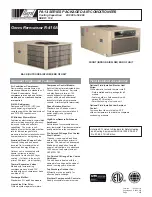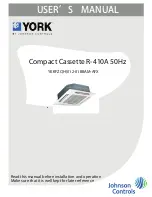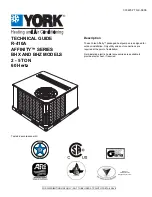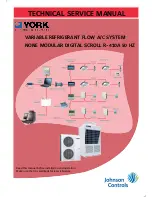
3 N
3 N
N~
L~
Drain cap
5. OUTDOOR UNIT INSTALLATION
INDOOR/OUTDOOR UNIT CONNECTING WIRE CON-
NECTION AND OUTDOOR POWER SUPPLY CORD
CONNECTION
•
Connect the indoor/outdoor unit connecting wire
A
from the indoor unit correctly
on the terminal block.
•
For future servicing, give extra length to connecting wire.
Drain hose
Downward
slope
Water
leakage
Do not raise.
Water leak-
age
Accumulated
drain water
Waving
Water
leakage
Tip of drain
hose dipped
in water.
Ditch
Air
4 Insert the drain hose into the section to which the drain hose is
to be attached at the rear right of the indoor unit.
Insert the drain hose fully into the drain pan. Check if the hose is hooked securely to
the projection of its inserting part at the drain pan.
Soft hose
I.D.
15 mm or
hard vinyl
chloride
Spacer assembly
Securely attach the spacer
assembly in the concave part of
the rib, taking care its direction is
correct as shown in the right.
Spacer
Cut part of packing material (spacer assembly) to
hook it on the back rib.
Drain
hose
Less than
50 mm gap
Loosen terminal screw.
Terminal block
Lead wire
<Connection details>
Power supply cord
K
Indoor terminal block
Outdoor terminal block
Indoor/outdoor unit
connecting wire
A
2-core 1.0 mm
2
3 Put the drain cap into the section to which the drain hose is to
be attached at the rear of the indoor unit.
Insert the screwdriver, etc. (not sharp-edged tool) into the hole at the end of the cap
and insert the cap fully into the drain pan.
(Fig.
4)
(Fig.
5)
•
If the drain hose provided with the indoor unit is too short, connect it with drain
hose
I
that should be provided at your site.
•
If the extension drain hose has to pass through a room, be sure to wrap it with
commercially sold insulation.
(Fig. 1)
(Fig. 2)
(Fig. 3)
•
Connect the refrigerant piping with the extension pipe
B
.
•
Thrust the lower part of the indoor unit into the installation plate
1
.
4-7 DRAIN PIPING
•
The drain hose should point downward for easy drain fl ow. (Fig. 1)
Do not make drain piping as shown in Fig. 2 to 5.
INDOOR UNIT INSTALLATION
•
Insert the drain hose into the wall hole sleeve
C
, and hook the upper part of
indoor unit on the installation plate
1
. Then, move the unit to the very edge of the
left side for putting the piping easily in the back space of the indoor unit. After that,
cut the part of packing material (spacer assembly) to hook it on the back rib and
lift the indoor unit as shown in the fi gure below.
CAUTION
•
Use care not to make mis-wiring.
•
Firmly tighten the terminal screws to prevent them from loosening.
•
After tightening, pull the wires lightly to confi rm that they do not move.
•
If the connecting wire is incorrectly connected to the terminal block, the unit
does not operate normally.
WARNING
•
A means for disconnection of the supply with an isolation switch, or similar
device, in all active conductors shall be incorporated in the fi xed wiring.
•
Never cut the power cord and connect it to other wires.
It may cause a fi re.
Power supply cord
Specifi cation
3-core 2.5 mm
2
or more, in conformity
with Design 60245 IEC 57.
10 m or less
Indoor and Outdoor
connecting wire
Specifi cation
Cable 2-core 1.0 mm
2
, in conformity with Design 60245
IEC 57.
•
For the power supply cord and the indoor/outdoor unit connecting wires, be sure to
use the ones in compliance with the standards.
•
Be sure to push the core until it is hidden and pull each cable to make sure that
it is not pulled up incomplete insertion may cause a risk of burning the terminal
blocks.
•
Peel off both ends of connecting wire (extension
wire). When too long, or connected by cutting off
the middle, peel off power supply wire to the size as
shown in the right.
•
Be careful not to contact connecting wire with piping.
•
Make earth wire a little longer than the others.
(more than 35 mm)
35 mm
15 mm
Rated Voltage Breaker capacity Connect to the supply terminals and leave a contact
separation of at least 3 mm at each pole to disconnect
the source power pole. (When the power switch is
shut off, it must disconnect all poles.)
230 V
25 A



























